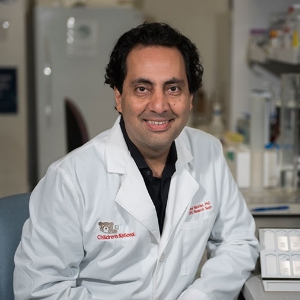Research And Grants

Children's National Medical Center - $200,000
Dr. Javad Nazarian
$200,000.00
October 2015
Translational
DIPG
Evaluating TORC1/2 kinase inhibition in murine and nonhuman primate (NHP) models
Scientific Merit: New therapies are desperately needed for children with DIPG. Our group participated in recent collaborative efforts that led to identification of panobinostat as an active agent in DIPG. However, additional agents are likely required in combination with panobinostat to improve long-term survival for these children. We identified mutations activating the mTOR signaling pathway in DIPGs. Our preliminary data shows that targeting mTOR using a dual TORC 1/2 inhibitor, MLN0128, suppresses DIPG growth and increases apoptosis. Our strong collaborative team will use existing available preclinical resources, including four primary DIPG lines, xenograft and allograft DIPG models, and a non-human primate model, to test DIPG response to MLN0128 and evaluate the CNS pharmacokinetics of this agent. Combinational (radiation, panobinostat) therapies will be used to assess additional impact. Our approach is based on solid preliminary data that will be further expanded using three strongly collaborating laboratories for establishing mTOR as a potential target for treating DIPGs. The clinical need, widespread activation of mTOR in DIPG, and availability of a potent drug that penetrates into the central nervous system argue for further studies of MLN0128 in DIPG. Disease Impact: The proposed project aims to explore development of a new therapeutic for DIPG. In the short-term, the investigation of MLN0128 as a therapeutic agent in DIPG will provide the pre-clinical data to support a clinical trial of this agent, potentially in conjunction with radiation/chemotherapy. Once we have the data generated by our studies, we aim to perform a clinical trial of this agent based upon a sound biological and pharmacokinetic rationale. Innovation: 1. First study to investigate MLN0128 in DIPG. 2. Use of nonhuman primate (NHP) model to study drug pharmacokinetics. a. Unique ability to concurrently sample plasma and CSF penetration at multiple time points in primates. 3. Comprehensive in vitro and in vivo analysis of MLN0128 and combinatory treatments. 4. Identification of molecular mechanism of sensitivity/insensitivity to MLN0128 treatment. 5. Potential for near future clinical assessment of MLN0128 for treating children with DIPG. Feasibility: PIs of the proposed project have generated preliminary data indicating feasibility of the proposed project. Upregulation of mTOR is a known path by which cells develop resistance to panobinostat, therefore we propose to test the TORC1/2 kinase inhibitor MLN0128 in DIPG. MLN0128 has been shown by the pediatric preclinical testing program (PPTP) to have significant activity against the D456 brain tumor xenografts. We have demonstrated MLN0128’s activity against atypical tertoid/rhaboid brain tumor orthotopic xenografts, indicating that the agent does penetrate thebrain. Proposed molecular, in vitro and in vivo studies are routine in designated laboratories. MLN0128 is currently being tested in adult GBM. MLN0128 is available through CTEP, meaning that the drug could potentially be available for pediatric clinical trials. As such we envision our proposed study will result in robust molecular justification for using this compound in treating DIPGs. Expertise: Dr. Nazarian (PI) at CNHS has extensive expertise studying the molecular profiling (mRNA, methylation, proteomics) of DIPGs. CNHS houses cutting-edge genomic, proteomic and preclinical testing murine facilities. Dr. Raabe (Co-PI) a pediatric oncologist at Johns Hopkins University School has extensive experience in cell culture, molecular biology, immunochemical analysis and xenografting. Dr. Raabe’s laboratory had developed a primary DIPG line (JHH DIPG1) extensively used for preclinical testing across many laboratories. Dr. Katherine Warren (Co-PI) is the head of Pediatric Neuro-Oncology Section at NCI. Dr. Warren has extensive pharmacologic expertise, and leads preclinical and clinical efforts in developing new therapeutic strategies for the treatment of children with tumors of the central nervous system.

